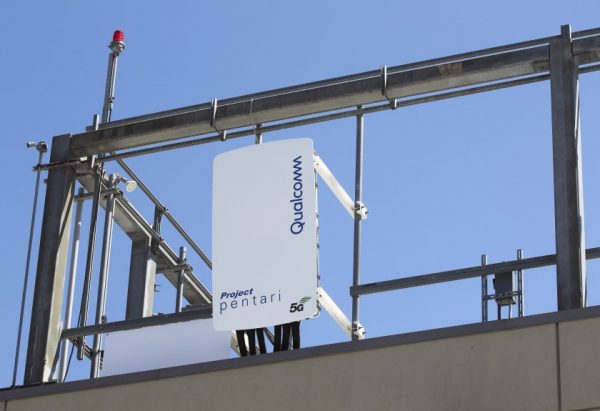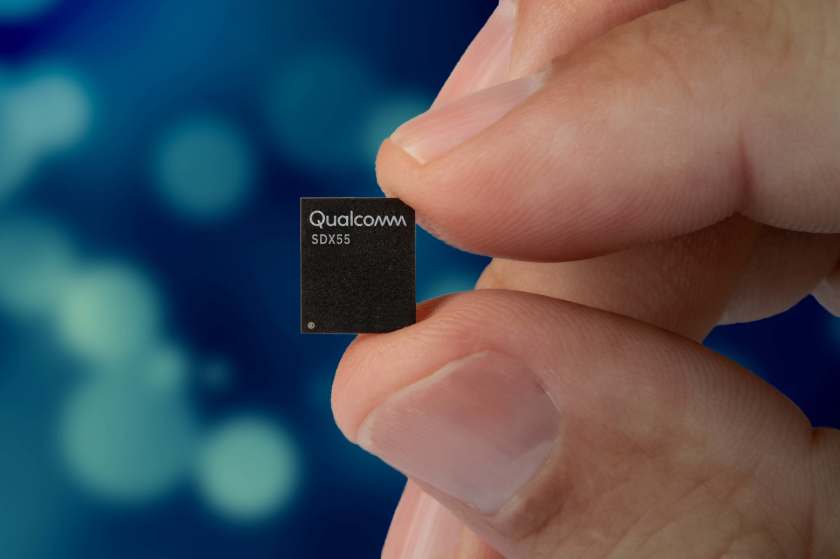Qualcomm CEO’s strategy through thick and thin: To win with better technology, led by 5G – The San Diego Union-Tribune
For Qualcomm Chief Executive Steve Mollenkopf, an already nasty, two-year legal fight with Apple became even uglier this past January.
Apple CEO Tim Cook said on television that the two companies had not discussed a settlement in months, essentially contradicting Mollenkopf’s claims that they were on the doorstep of a resolution.
The language used by the CEOs was vague. Both could have been accurate. Qualcomm fired off a statement claiming Apple’s comments appeared to be deliberately timed to attempt to tarnish Qualcomm’s reputation. Apple stood by what Cook said.
In the end, the companies did settle their global legal war a few months later after opening arguments in an April trial — eerily close to the time-table Mollenkopf had been predicting internally
“I said it would settle on the courthouse steps, and it was the day of the trial,” he said. “So I was off by one day.”
It was a stunning outcome for Mollenkopf, bringing Qualcomm’s largest customer back into the fold with a six-year patent license agreement and an undefined, multi-year chip supply deal.
Mollenkopf’s prediction wasn’t random. It was informed by previous wars Qualcomm has fought with the likes of Nokia and Broadcom more than a decade ago.
“A lot of us have been working together for 20-plus years. The company’s history and culture was hardened by these types of things,” said Mollenkopf. “It wasn’t like we didn’t already play in a very tough gym.”
Now he’s hoping to change the narrative around the company from being centered around legal skirmishes to technology, particularly faster 5G networks.
“I feel we do things the right way,” he said. “We play in a technology area that is so competitive and is global. What that means is you have to be able to compete with the toughest competitors out there. You have to be able to stand up for those things that you think you deserve.”
Thick skin
During one particularly tough stretch of his five-year tenure at the helm of Qualcomm, Mollenkopf felt the need to phone his parents.
“I said there is going to be a lot of stuff you are going to hear and read about me,” said Mollenkopf. “Just ignore it. I can handle it.”
A thick skin is a requirement of any executive at a major company, but it has been particularly vital for Mollenkopf. Since he took over as Qualcomm’s chief executive in 2014, the company has faced one blitzkrieg after another.
Chinese regulators attacked fees Qualcomm charges to license its cellular inventions. In a settlement, Qualcomm agreed to charge less inside China.
Activist investor Jana Partners pushed Qualcomm to probe splitting the company’s two main divisions — patent licensing and smartphone processor chips — into separate companies. After a review, Qualcomm’s board decided to keep chips and licensing under one umbrella.
A two-year, $44 billion effort to buy NXP Semiconductors, which would ease Qualcomm’s dependence on smartphones, collapsed when Chinese regulators balked at approving the deal amid the U.S.-China trade war.
The U.S. Federal Trade Commission and Apple sued alleging antitrust violations. Other regulators in South Korea and elsewhere also challenged Qualcomm’s business practices.
Then chip rival Broadcom launched a hostile takeover bid for Qualcomm, the largest in history of the U.S. technology sector. It only failed after the Trump administration blocked it on national security grounds.
During all this turmoil, Mollenkopf’s strategy was to win with better technology, led by 5G.
“Steve made the case very convincingly that our technology was going to be the technology that was needed, and that would rule the day,” said former American Airlines CEO Tom Horton, who stepped down this year as lead independent director of Qualcomm’s board.

A Qualcomm 5G antenna can be seen on the roof of the Qualcomm headquarters in San Diego.
(Hayne Palmour IV/The San Diego Union-Tribune)
The company ramped up its innovation engine to help accelerate the roll out of faster 5G wireless networks a year ahead of schedule.
“The most important thing that Steve and his executive team could do was keep the engineers and broader employee base driving to stronger and stronger leadership with the technology, which they did,” said Ann Livermore, a Qualcomm board member and former executive vice president of Hewlett Packard Enterprise.
The emergence of 5G brought Apple to the negotiating table. Qualcomm is expected to supply 5G chips for iPhones coming out next year.
“In the end, it was the quality of our technology that drove Apple and Qualcomm to be able to come to an agreement,” said Livermore. “I think Steve was very consistent with that view, and (the board) believed it as well.”
While 5G is still in its early stages, its potential has pushed Qualcomm’s stock to near 20-year highs over the past several weeks. The stock closed Friday at $90.81.
The company is not out of the woods. An appeal is pending of an antitrust ruling against Qualcomm in the FTC case, which could upend the way the company funds research and development.
Huawei, China’s largest smartphone maker, continues to withhold patent royalty payments in a dispute.
And in the saturated smartphone market, it’s unclear whether 5G can spark a significant rebound.
“4G was a reason to go out and buy a smartphone, and Qualcomm tripled its revenue over a four or five-year period because of this,” said Stacy Rasgon, an analyst with Bernstein Research. “5G feels more like a replacement market, so there may not be the same unit opportunity that you had with 4G.”
Still, things have settled down since the Apple settlement.
“We got through it,” said Mollenkopf. “The companies respect each other. We are two big companies that are used to getting our way but also moving on. What dominates the discussion now is engineering.”
Comfortable with uncertainty
Mollenkopf, 50, grew up in Baltimore — the son of teachers. He got a bachelor’s degree in electrical engineering from Virginia Tech, where he played club-level lacrosse. At the suggestion of his older brother, he applied for a job at Qualcomm in 1994 shortly after earning a master’s degree from the University of Michigan.
“I took the job and I remember exactly what I said to my wife,” he recalled. “I called her and said everybody here is smarter than me. That seems like a great place to start.”
He wasn’t sure he would stick with the company, however. He put off buying a house in San Diego for five years.
As he advanced through the ranks, Mollenkopf often worked on projects outside of Qualcomm’s mainstream technology focus at the time.
“It was more like we better work on these things in case they work out,” said Mollenkopf. “One of the reasons I was there is that I was probably more comfortable going into assignments that seemed higher risk, and they ended up being real backbones of the company.”

Qualcomm’s 5G cellular modem chip
(Qualcomm)
These projects included development of chips in an alternative flavor of 2G/3G technology called Wideband Code Division Multiple Access. WCDMA was more widely used globally than Qualcomm’s core Code Division Multi Access (CDMA) technology — opening up a larger market.
He was a champion for combining cellular modems — Qualcomm’s core semiconductor product — with computer processors in a single chip. That effort morphed into today’s Snapdragon semiconductors, which power many of today’s Android smartphones.
By 2008, Mollenkopf was running Qualcomm’s chip business. Ahead of the transition to 4G, he advocated for LTE radio technology for high-speed Internet connections. At the time, Qualcomm was pursuing a homegrown technology called ultra-mobile broadband.
LTE turned out to be the foundation of 4G, and Qualcomm , through acquisitions and internal research, emerged as the market leader.
Mollenkopf became chief operating office in 2011. After Microsoft began courting him, he was named CEO, becoming the first head the San Diego’s largest public company who wasn’t a member of the founding Jacobs family.
No honeymoon
Mollenkopf’s honeymoon as CEO was short.
During that first year, smartphone sales growth slowed to 7 percent, compared with 30 percent growth the three prior years. Sales have been declining ever since.
Mollenkopf restructured to reduce costs. Qualcomm laid off 1,300 workers in San Diego in 2015, and another 1,500 workers last year. The company now employs around 10,000 workers locally.
Then came the challenges from global regulators, Apple and Broadcom.
Mollenkopf said he knew many of these fights were coming, including with Apple.
“If it was going to be a tough period, I would rather that I was trying to figure it out with a bunch of folks that I trust,” he said. “To me, there’s some psychological thing where if you’re in control in a tough situation, there is less stress than if you are not in control.”
Calm and deeply analytical, Mollenkopf still has work to do with shareholders. Many supported Broadcom’s hostile takeover before it was blocked. While the company has a good 5G growth story, it has yet to deliver the financial results it promised during the takeover showdown.
The company will hold its first event for analysts and fund managers in four years this week in New York. After the NXP deal fell apart, the company bought back a large number of shares. It is expanding its content in more complex 5G smartphones in hopes of growing revenue even if 5G sales aren’t spectacular.
Already, it has inked deals to supply 5G chips to 230 devices either on the market today or in the pipeline. The company forecast 200 million 5G phones will be sold next year.
“While Qualcomm’s legal action with the FTC still represents a significant risk, as Qualcomm shareholders, we believe (Mollenkopf) deserves kudos for concurrently navigating Qualcomm through its royalty collection legal problems while also driving 5G forward a year earlier than expected,” said Steven Re, president of Fairbanks Capital Management in Rancho Santa Fe, in an email.
Mollenkopf, an inventor on 38 patents, doesn’t think getting through the litigation with Apple marks the end of outside challenges for Qualcomm.
“We are in an industry — and in a position in the industry — where that kind of stuff just comes with the badge,” he said. “The company feels, and I definitely feel, that anything that is thrown at us we can deal with it.”






